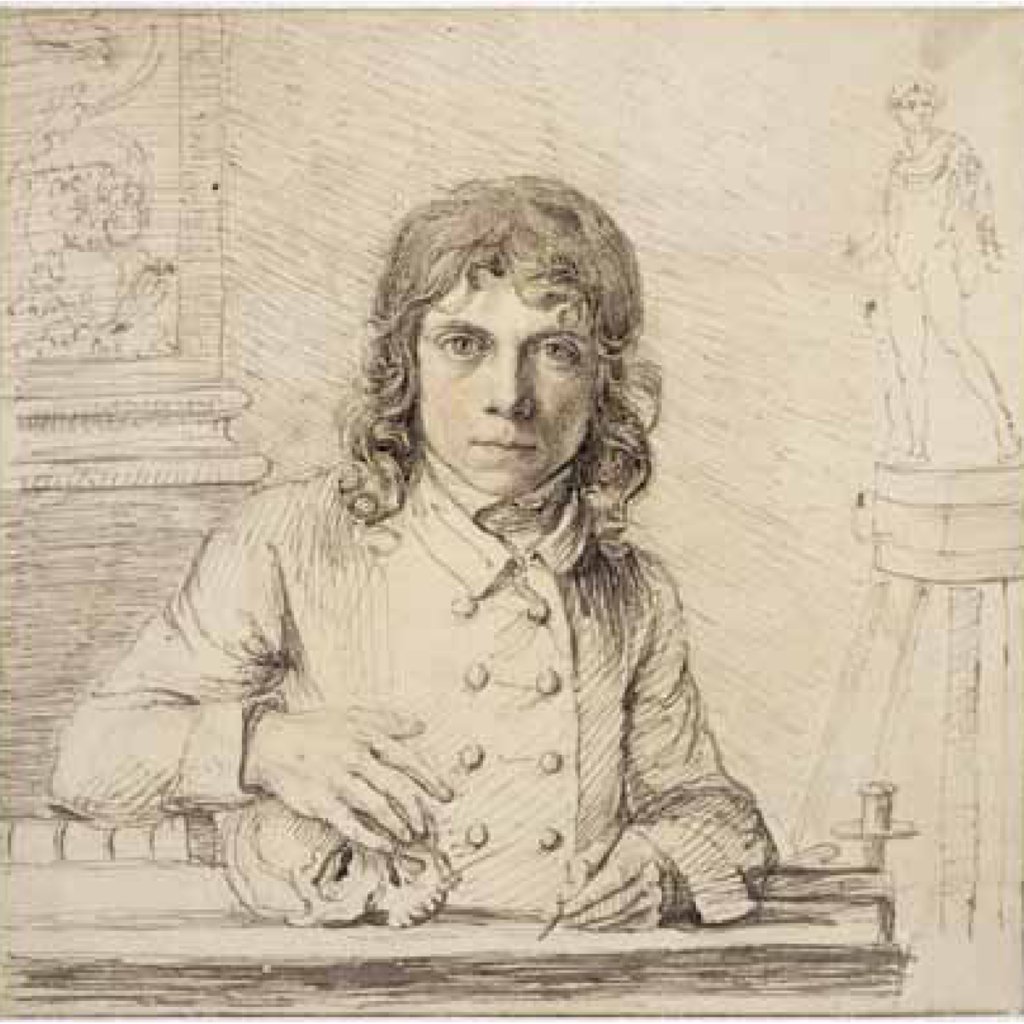A Matter of Likeness by Liz Rideal
To celebrate National Portrait Day, Professor Liz Rideal explores some of the portraits included in the book, Slade Drawing 150, part of the Slade's 150 year anniversary celebrations.
A good portrait contains not only likeness but a level of quality in production. How can we tell if a portrait looks like somebody? Knowing that person, of course, and having another image of that person whether in paint, film or photograph.
David Burrows

©the artist
David Burrows’ (b.1965) drawing does two things in relation to resemblance and the portrait; he isolates two elements that we know relate to the pursuit of likeness. We recognise Count Dracula (b.1897 in Bram Stoker’s (1847-1912) novel) by his fangs and we recognise David within his family tree where the family characteristics repeat within the sets of siblings and parents. Burrows conjoins the elements in his witty self-portrait.
John Flaxman
John Flaxman’s R.A.(1755-1826) self-portrait was created in the days before photography so in order to confirm his likeness, we need to look at other self-portraits by him to check his salient features, for example the terracotta roundel in the Victoria and Albert Museum, London (Accession number 294:1, 2-1864) made when he was a student in 1778. This work was later owned by Sir William Hamilton (1730-1803), the British ambassador to Naples. Flaxman was prolific and known primarily as a sculptor, in drawing he favoured pen and ink (an unforgiving medium with regard to mistakes). This piercing pen portrait shows his deliberate workings on paper and one can almost hear the scratching on its surface. Of course, the ageing process complicates the quest for likeness and the body has its own way of changing itself. However, the basic shape and volume of a skull remains the same during a lifetime and Flaxman’s youthful portrait includes one to remind us of this underlying structure of the head and more.
Flaxman portrait

Self-portrait of John Flaxman

©V&A Museum
Alphonse Legros

©UCL Art Collection, LDUCS - 1384
Moving from the eighteenth century to the late nineteenth century work of Alphonse Legros (1837-1911), we begin to appreciate the issues, problems and techniques of style. His delicate drawing is made with silverpoint onto coloured prepared paper, meaning that he used a silver stylus to indent his marks into the paper leaving a faint trace of metal which would grow stronger as the mark oxidised. He used chalk to highlight his strong forehead and the modulated features. Legros’ fashionable beard also locks this work into the nineteenth century time-frame. This former Slade Professor and Director was French and spoke little English, it is said that he taught his etching classes by example, rather than communicating verbally.
Photography invented in the 1850’s, can be used to verify his likeness here, by comparing his drawing with another self-portrait in the Metropolitan Museum of Art, New York (Accession Number: 2007.49.504) and a photograph from 1860-70, by David Wilkie Wynfield (1837-1887).
Naira Mushtaq

©the artist
Naira Mushtag’s (b.1990) use of paint and collage takes the materiality of portraiture into the twenty-first century. Her collage portrait offers two figures, with the torso in one obscured and the face obliterated, the viewer is obliged to surmise the identity of the second person; in place of the head is a rectangular abstract painting. The puzzle is confounded by the young person fixing their gaze on us, forcing our focus onto this specifically isolated individual in a domestic environment. The portrait here extends its remit and we enter what appears to be a nostalgic world, is this the world of “15_07_1962” as the title would have us believe? The artist comments, “I do see my work as a self-portrait, however in this case the gaze is what stayed with me. The small polaroid was discarded and found near Warren Street.”
Conclusion
The setting for a portrait can be a useful indicator of information about the sitter. Mushtag and Flaxman’s do this. In the latter, the skull is a symbolic device known as a Memento Mori. Flaxman seen holding it, embodies a comment on the brevity of human life on earth and implies eternal Heavenly existence after death. The inspiration of the Burrows-Dracula family portrait is in the conflation of the idea of the portrait with an ‘anti-Memento Mori’ gesture. We know through literature that Dracula is condemned to eternal life on Earth, surviving by nightly blood-sucking in the dark, a continual process of death to others and life to Dracula. This contemporary twist on classical portraiture is funny and clever and re-engages viewers with the basic tenets of the traditional genre of portraiture.